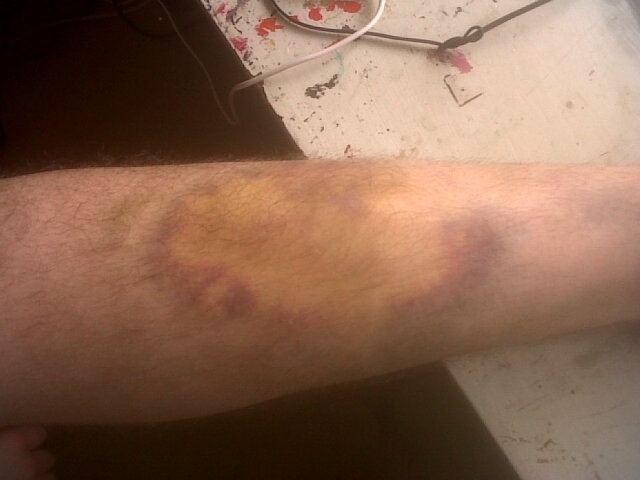 | ||
A Soft tissue injury (STI) is the damage of muscles, ligaments and tendons throughout the body. Common soft tissue injuries usually occur from a sprain, strain, a one off blow resulting in a contusion or overuse of a particular part of the body. Soft tissue injuries can result in pain, swelling, bruising and loss of function (Lovering, 2008)
Contents
Acute injuries
Any type of injury that occurs to the body through sudden trauma, such as a fall, twist, or blow to the body. A few examples of this type of injury would be sprains, strains, and contusions.
Overuse injuries
An overuse injury occurs when a certain activity is repeated frequently, and the body doesn't have enough time to recover in between occurrences. Some examples include bursitis and tendinitis.
Sprains
A sprain is a type of acute injury which results from the stretching or tearing of a ligament. Depending on the severity of the sprain, the movement on the joint can be compromised since ligaments aid in the stability and support of joints. Sprains are commonly seen in vulnerable areas such as the wrists, knees, and ankles. They can occur from movements such as falling on an outstretched hand, or a twisting of the ankle or foot.
The severity of a sprain can also be classified:
Grade 1: Only some of the fibers in the ligament are torn, and the injured site is moderately painful and swollen. Function in the joint will be unaffected for the most part.
Grade 2: Many of the ligament fibers are torn, and pain and swelling is moderate. The functionality of the joint is compromised.
Grade 3: The soft tissue is completely torn, and functionality and strength on the joint is completely compromised. In most cases, surgery is needed to repair the damage.
Strains
A strain is a type of acute injury that occurs to the muscle or tendon. Similar to sprains, it can vary in severity, from a stretching of the muscle or tendon to a complete tear of the tendon from the muscle. Some of the most common places that strains occur are in the foot, back of the leg (hamstring), or back.
Bruising (Contusion)
A contusion is the discoloration of the skin, which results from underlying muscle fibers and connective tissue being crushed.This can happen in a variety of ways such as a direct blow to the skin, or a fall taken against a hard surface.The discoloration in the skin is present when blood begins to pool around the injury.
Tendinitis
Tendinitis is a type of overuse injury to the tendons, which demonstrates signs of inflammation of tendons around a joint. Tendinitis is the most common cause of shoulder pain.Tendinitis occurs when there is repetitive stress on the subacromial bursa, which causes the bones to make contact with the tendons and irritate them.
Commonly Injured Tissues
With examples of each
Parentheses indicate location in body
-Ligaments
Anterior Cruciate Ligament (Knee), Medial Collateral Ligament (Knee), Ulnar Collateral Ligaments (Wrist/Hand), Interspinous Ligaments (Vertebrae)
-Muscles
Biceps Brachii (Upper Arm), Rectus Femoris (Thigh), Transverse Abdominus (Abdominals)
-Tendons
Patellar Tendon (Knee), Calacaneal/Achilles Tendon (Foot/Lower Leg), Biceps Tendon (Shoulder/Elbow)
-Nerves
Brachial Plexus (Shoulder), Ulnar Nerve (Elbow/Hand), Peroneal Nerve (Ankle/Foot), Cranial Nerves I-XII(Head)
-Bones
Femur (Leg), Humerus (Arm), Ribs (Torso), Metatarsals I-VI (Foot), Metacarpals I-VI (Hand)
-Cartilage
Menisci (Knee), Intervertebral discs (Spine), Acetabulum (Hip)
R.I.C.E Method: (Rest, Ice, Compression, Elevation)
The RICE method is an effective procedure used in the initial treatment of a soft tissue injury.
Rest: It is suggested that you take a break from the activity that caused the injury in order to give the injury time to heal.
Ice: The injury should be iced on and off in 20 minute intervals, avoiding direct contact of the ice to the skin.
Compression: Bandaging the injury will compress it, and prevent any further bleeding or swelling to occur.
Elevation: Elevating the injury above your heart while you are resting will aid in the reduction of swelling.
No H.A.R.M Protocol: (Heat, Alcohol, Re-injury, Massage)
This method should be used within the first 48–72 hours after the injury in order to speed up the recovery process.
Heat: Applying heat to the injured area can cause blood flow and swelling to increase.
Alcohol: Alcohol can inhibit your ability to feel if your injury is becoming more aggravated, as well as increase blood flow and swelling.
Re-injury: Avoid any activities that could aggravate the injury and cause further damage.
Massage: Massaging an injured area can promote blood flow and swelling, and ultimately do more damage if done too early.
Treatment
If severe pain persists after the first 24hours it is recommended that an individual consult with a professional who can make a diagnosis and implement a treatment plan so the patient can return to everyday activities (Flegel, 2004). These are some of the tools that a professional can use to help make a full diagnosis;
Nerve conduction studies may also be used to localize nerve dysfunction (e.g., carpal tunnel syndrome), assess severity, and help with prognosis. Electrodiagnosis also helps differentiate between myopathy and neuropathy.
Ultimately, the best method of imaging soft tissue is magnetic resonance imaging (MRI), though it is cost-prohibitive and carries a high false positive rate.
